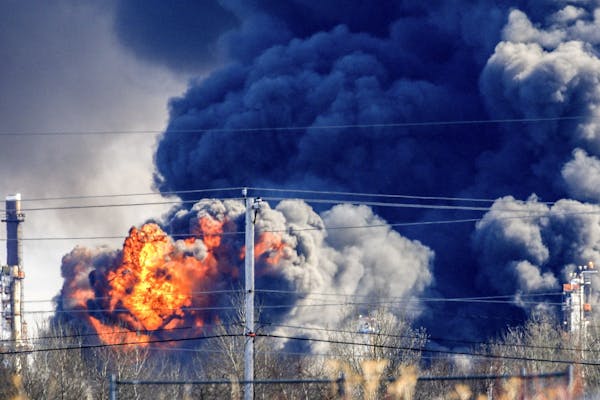Husky Energy will continue using hydrogen fluoride, a highly toxic chemical, at the Superior, Wis., refinery that exploded and burned a year ago.
The Calgary-based company announced Tuesday it will spend more than $400 million to rebuild the refinery but said that ditching hydrogen fluoride would not be economically practical. Some Twin Ports residents and public officials have urged Husky to retool its refining process to eliminate the chemical.
Tanks of hydrogen fluoride were never breached during the conflagration, which was caused by an eroded valve. But large parts of Superior, a city of about 27,000, were evacuated because of fears of its release.
Hydrofluoric acid, which is hydrogen fluoride dissolved in water, is used as a catalyst to boost octane in gasoline at about half of the nation's refineries. Accidents involving the chemical are rare. But a hydrofluoric acid release can cause severe burns and — in a worse-case scenario — a deadly gas cloud.
"The largest risk to the public at the Husky refinery is undoubtedly hydrogen fluoride," said Ginger Juel, co-founder of the Twin Ports Action Alliance, which has campaigned against the chemical's use. "Is public safety less important than the investors' bottom line?"
Husky, in a news release, said it plans safety enhancements to its hydrogen fluoride use, including enhanced leak detection and "additional layers of water mitigation." Water helps to dilute hydrofluoric acid in case of a leak.
Juel questioned the adequacy of water mitigation systems if flying shrapnel from an explosion were to pierce tanks filled with hydrogen fluoride.
An explosion ripped through the Superior refinery on April 26, 2018, and debris from the blast punctured a steel tank full of asphalt, spilling more than 15,000 barrels and eventually causing a major fire, according to a federal government analysis of the accident. The refinery's hydrogen fluoride tank was in the vicinity of the asphalt tank.
Another federal investigation, this one by the Occupational Safety and Health Administration, found that the explosion and fire could have been prevented if the plant's equipment had been properly maintained.
Husky said Tuesday that construction on the Superior refinery is expected to begin this fall, with a target of resuming partial operations in late 2020. The nearly 70-year-old refinery employs about 200 people when it's running. The rebuild will create 350 construction jobs, Husky said.
The company said it considered alternatives to hydrogen fluoride. About half of U.S. refineries use sulfuric acid to boost octane levels in gasoline. Sulfuric acid is hazardous, too, but it doesn't vaporize as easy as hydrofluoric acid.
No U.S. refinery has converted from hydrofluoric acid, though Chevron plans to do so at its Salt Lake City refinery using a new technology. Husky said that technology has not yet been "commercially proven."
The company said it considered converting to sulfuric acid at the Superior refinery but concluded it wasn't "commercially viable." Such a conversion presents "substantial technological and operational challenges" and would result in increased air emissions and greenhouse gases, the company said.
Husky did not put a price tag on a move to sulfuric acid, but cost is likely the company's biggest risk. Converting a refinery from the hydrofluoric-acid process costs tens of millions of dollars — an investment that doesn't generate more revenue.
The Superior refinery is a major source for gasoline and other oil products in the Twin Ports. Still, it's a small refinery, with production capacity of 38,000 barrels of oil per day.
Flint Hills' sprawling Pine Bend refinery in Rosemount and Marathon's refinery in St. Paul Park respectively have barrel-per-day capacities of about 100,000 and around 310,000. The Marathon refinery uses hydrofluoric acid to boost octane; Flint Hills, sulfuric acid.
Mike Hughlett • 612-673-7003

University of Minnesota police arrest 9 after pro-Palestinian encampment set up on campus
2 dead in Lino Lakes, no known threat to public, police say
Teen charged with murder in deadly St. Paul shooting last month

